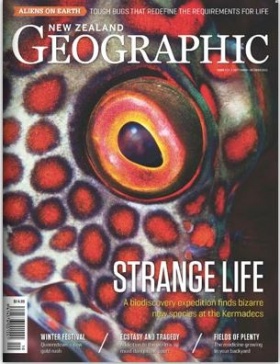Blue Water Islands - New Zealand Geographic Article

It’s tempting to suggest that the Kermadec Islands are in the middle of nowhere—but really, they're in the middle of everywhere. They are a meeting place, an intersection. Lord Howe and Norfolk islands sit at the same latitude 2250 and 1350 km to the west respectively, New Zealand is the largest neighbour 730 km to the south-west, and the islands of Tonga are a logical continuation a thousand or so kilometres to the north-east.
The Kermadecs are a reflection of both that proximity and distance. Politically they are part of New Zealand. Biogeographically, they are distinct, straddling latitudes 29°14'S to 31°24'S. They sprawl across 250 km of ocean, from the austere L'Esperance Rock in the south, past the small but imposing huddle of sulphur-perfumed Curtis and Cheeseman islands, the brooding wedge of Macauley Island, to the lush northern outpost of Raoul and its cluster of outliers. Tiny specks of land in a vast ocean.
But beneath the surface, a whole new context is revealed. The islands are mere mountain-tops, part of a mighty line of volcanoes which mark another meeting place—one of tectonic plates, where the Pacific Plate is subducted beneath the Australian Plate. As the Pacific Plate dives down, it drags and bends the edge of the Australian, which results in the Tonga Trench, a 10-km-deep rift that is one of the deepest places on Earth. To the west of the trench, the Australian Plate buckles upwards to create the Kermadec Arc, which joins the Tonga Ridge in a 2000-km-long mountain chain. The Pacific Plate is forced to great depth, perhaps 200 km into the Earth’s crust, and melts, generating a great wellspring of hot magma which erupts at various points along the ridge, creating the line of submarine volcanoes defining the southern part of the Pacific Ring of Fire.
There are 40 or so volcanic centres, many active, most submarine, stretching from White Island in the south, past the Rumbles and Brothers, Monowai and Hinepuia, to name but a few. About two-thirds of the volcanoes resemble classic volcanic cones, while the remainder are vast calderas, created by the collapse of the volcano's summit. Rumble III measures 25 km across at the base, while Macauley Island is just the top five per cent of an enormous submerged volcano with a 10-km-long caldera. Recently, it was been discovered that Raoul is the uplifted portion of two giant caldera volcanoes. In the past ten years, underwater exploration involving remote-operated vehicles (ROVs), autonomous underwater vehicles (AUVs), manned submersibles and multibeam mapping of the sea floor has revealed a complex and varied terrain, a hot bed of hydrothermal activity where vents spew hot water into the ocean, creating sulphurous chimneys known as ‘black smokers’.
The legacy of all this volcanism is an unsettled world, constantly in flux. Frequent earthquakes, outpourings of lava, ash clouds and huge quantities of pumice ensure that nothing stays the same for long. Volcanoes have been created and destroyed many times in the five million years that this arc has been active, islands have come and gone. Even an island as large as Raoul is estimated to have been above water for just one or two hundred thousand years. Yet despite this impermanence of land, life has taken hold above and below water, demonstrating both an incredible resilience and a great ability to disperse.
View the latest issue of New Zealand Geographic. The magazine feature includes 20 lavish photographs spread over 29 pages and is available from the New Zealand Geographic store or most good bookstores.
Author: Alison Ballance
Published in Issue 111 Sept - Oct 2011












